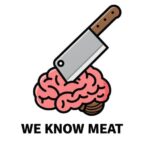The journey from a whole side of beef to the steak on your plate involves several stages of butchering and processing. These stages can be categorized into primal cuts, subprimal cuts, and retail cuts. Each level serves a specific purpose, catering to different buyers and needs, whether you’re a restaurant, a grocery shopper, or a home cook.

The History of Beef Primals
The concept of beef primals dates back centuries, rooted in the need to standardize meat cutting for efficient processing and trade. In early European markets, cattle were butchered into large sections to simplify storage, transport, and sale. These larger sections were often divided by muscle groups and bone structure, creating the foundation for what we now know as primal cuts.
By the 19th century, the industrial revolution brought advancements in refrigeration and transportation, enabling meat to be processed in centralized locations. This shift further solidified the use of primal cuts as a standardized method, allowing meat packers to distribute uniform sections of beef to markets and restaurants across the globe.
Today, the concept of primal cuts remains central to modern butchery, ensuring efficiency and consistency in how beef is processed and sold.
Primal Cuts
Primal cuts are the first large sections that a butcher separates from a side of beef during the initial breakdown. These cuts represent broad regions of the animal and include:
- Chuck: Shoulder area, ideal for roasts and ground beef.
- Rib: Rib section, home to ribeye steaks and prime rib.
- Loin: Includes the tenderloin and strip loin, known for tender steaks.
- Round: Hindquarters, often used for roasts and lean cuts.
- Brisket: Breast section, perfect for slow cooking.
- Plate: Lower rib section, where short ribs and skirt steak come from.
- Flank: Abdominal area, used for flank steak.
- Shank: Legs, specifically above the knee. Great for stewing.
Who Buys Primals? Restaurants, foodservice providers, and large-scale buyers typically purchase primal cuts. These buyers often process primals into smaller portions tailored to their menu needs.
Subprimal Cuts
Subprimal cuts are sections taken from the primal cuts during further processing. These cuts are smaller and more manageable but still require additional trimming or portioning before they are ready for consumers. Subprimals include:
- From the Rib Primal: Ribeye roll (used for ribeye steaks), short ribs.
- From the Loin Primal: Strip loin (used for New York strip steaks), tenderloin (used for filet mignon).
- From the Chuck Primal: Chuck roll (used for chuck steaks and roasts).
Who Buys Subprimals? Subprimals are often sold at grocery stores and warehouse clubs. Savvy shoppers can purchase subprimal cuts at a discount and portion them into smaller retail cuts at home, saving money in the long run.
Retail Cuts
Retail cuts are the final products that consumers purchase, neatly trimmed, portioned, and packaged for convenience. These cuts are ready to cook and come with familiar names, such as:
- Ribeye steak (from the ribeye roll).
- Filet mignon (from the tenderloin).
- Chuck roast (from the chuck roll).
- Ground beef (from trimmings of various cuts).
Who Buys Retail Cuts? Retail cuts are purchased by home cooks and everyday consumers. They are widely available at grocery stores, butcher shops, and supermarkets.
The Difference Between Western Primal Cuts and Other Cultures
While Western butchery is rooted in the concept of primal cuts, other cultures approach meat cutting differently, reflecting local culinary traditions and priorities.
Western Primal Cuts
In Western butchery, beef is divided into eight primary sections:
- Chuck: The shoulder, known for its bold flavor and versatility.
- Rib: Home to prized cuts like ribeye and prime rib.
- Loin: A tender section offering cuts like tenderloin and strip steak.
- Round: The lean hindquarter, ideal for roasting and braising.
- Brisket: A flavorful, fatty cut from the chest, perfect for slow cooking.
- Plate: A flavorful section below the rib, used for short ribs and skirt steak.
- Flank: A lean, flavorful cut from the lower belly.
- Shank: The leg portion, ideal for braising and soups.
Butchery in Other Cultures
- French Butchery: Known as “seam butchery,” the French system focuses on separating muscles along natural seams, resulting in finer, more delicate cuts.
- Asian Butchery: In countries like Japan and China, butchers prioritize smaller, thinner cuts suited for stir-frying, grilling, and hot pot. Wagyu beef, in particular, is often cut to highlight its intricate marbling.
- Latin American Butchery: Cuts like picanha (top sirloin cap) and asado (short ribs) reflect the grilling traditions central to cuisines in Brazil and Argentina.
- Middle Eastern and African Butchery: In regions where stews and slow-cooked dishes are common, butchers focus on smaller, bone-in cuts to maximize flavor extraction.
Why Understanding the Hierarchy Matters
Understanding the progression from primal to subprimal to retail cuts can help you make smarter purchasing decisions:
- For Restaurants: Buying primal cuts allows flexibility in creating custom cuts and reduces costs.
- For Savvy Shoppers: Purchasing subprimal cuts can provide significant savings while offering the opportunity to create custom portions.
- For Convenience: Retail cuts are ideal for those who value convenience and simplicity.
Plus, for those passionate about sustainable eating, understanding primals can help reduce waste by encouraging the use of lesser-known cuts that are equally delicious when prepared correctly.
By knowing the distinctions between these stages, you can tailor your buying strategy to your cooking needs, budget, and preferences. Whether you’re a professional chef or a home cook, this knowledge ensures you get the most value from your meat purchases.
